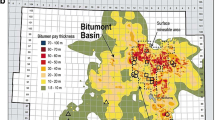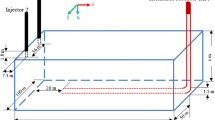Abstract
Given enormous capital costs, operating expenses, flue gas emissions, water treatment and handling costs of thermal in situ bitumen recovery processes, improving the overall efficiency by lowering energy requirements, environmental impact, and costs of these production techniques is a priority. Steam-assisted gravity drainage (SAGD) is the most widely used in situ recovery technique in Athabasca reservoirs. Steam generation is done on surface and consequently, because of heat losses, the energy efficiency of SAGD can never be ideal with respect to the energy delivered to the sandface. An alternative to surface steam generation is in situ combustion (ISC) where heat is generated within the formation through injection of oxygen at a sufficiently high pressure to initiate combustion of bitumen. In this manner, the heat from the combustion reactions can be used directly to mobilize the bitumen. As an alternative, the heat can be used to generate steam within the formation which then is the agent to move heat in the reservoir. In this research, alternative hybrid techniques with simultaneous and sequential steam-oxygen injection processes are examined to maximize the thermal efficiency of the recovery process. These hybrid processes have the advantage that during ISC, steam is generated within the reservoir from injected and formation water and as a product of oxidation. This implies that ex situ steam generation requirements are reduced and if there is in situ storage of combustion gases, that overall gas emissions are reduced. In this research, detailed reservoir simulations are done to examine the dynamics of hybrid processes to enable design of these processes. The results reveal that hybrid processes can lower emitted carbon dioxide-to-oil ratio by about 46%, decrease the consumed natural gas-to-oil ratio by about 73%, reduce the cumulative energy-to-oil ratio by between 40% and 70% compared to conventional SAGD, and drop water consumption per unit oil produced. However, oil recovery is between 25% and 40% below that of SAGD. Design of successful hybrid steam–oxygen processes must take into account the balance between injected steam and amount of injected oxygen and combustion gas products that dilute injected and in situ-generated steam in the depletion chamber by lowering its partial pressure, and thus its saturation temperature which in turn impacts production rates and recovery.























Similar content being viewed by others
References
Adegbesan, K.O., Donnelly, J.K., Moore, R.G., and Bennion, D.W., 1987. Low-Temperature-Oxidation Kinetic Parameters for In Situ Combustion: Numerical Simulation. SPE Reservoir Evaluation and Engineering, 2(4): 573-582.
Agca, C. and Yortsos, Y.C., 1985. Steady-State Analysis of In Situ Combustion. SPE Paper 13624: 347-362.
AED (Alberta Economic Development), 2007, Oil sands industry update. Available at Alberta Department of Energy. http://www.energy.gov.ab.ca.
Alberta Environment, 2007, Government of Alberta. http://environment.alberta.ca.
Belgrave, J. D. M., Bennion, D. W., Moore, R. G., Gie, D. N., and Ursenbach, M. G., 1986, Report of combustion tube tests. A.O.S.T.R.A. no. 50—Athabasca no. 45. Department of Chemical and Petroleum Engineering, University of Calgary.
Belgrave, J.D.M., Moore, R.G., Ursenbach, M.G., and Bennion, D.W., 1990. A Comprehensive Approach to In Situ Combustion Modeling. SPE Paper 20250: 98-107.
Belgrave, J. D. M., Nzekwu, B., and Chhina, H. S., 2007, SAGD optimization with air injection, in Latin American & Caribbean Petroleum Engineering Conference, Buenos Aires, Argentina, SPE Paper 106901.
Chu, C., 1982, State-of-the-art review of fire flooding field projects: J. Pet. Tech., v. 34, p. 19–36.
CMG, 2007, STARS™ User guide: advanced process and thermal reservoir simulator: Computer Modelling Group Ltd., Calgary, Alberta, Canada.
Denbina, E.S., Boberg, T.C., and Rotter, M.B., 1991. Evaluation of Key Reservoir Drive Mechanisms in the Early Cycles of Steam Stimulation at Cold Lake. SPE Reserv. Eval. Eng., 6(2): 207-211.
Galas, C.M.F. and Ejiogu, G.C., 1993. Enhancement of In Situ Combustion by Steam Stimulation of Production Wells. SPE Reservoir Evaluation and Engineering, 8(4): 270-274.
Greaves, M., and Turta, A. T., 1997, Oilfield in situ combustion process: U.S. patent number 5,626,191.
Hajdo, L. E., Hallam, R. J., and Vorndran, L. D. L., 1985, Hydrogen generation during in situ combustion: SPE paper 13661.
Hallam, R.J., Hajdo, L.E., Donnelly, J.K., and Baron, R.P., 1989. Thermal Recovery of Bitumen at Wolf Lake. SPE Reservoir Evaluation and Engineering, 4(2): 178-186.
Hallam, R. J., 1991. Operational techniques to improve the performance of in situ combustion in heavy-oil and oil-sand reservoirs: SPE paper 21773.
Jia, N., Moore, R.G., Mehta, S.A., Ursenbach, M.G., and Hancock, M., 2006. Kinetic modelling of thermal cracking and low temperature oxidation reactions. J. Can. Pet. Tech., 45(9): 21-28.
Le Thiez, P.A. and Lemonnier, P.A., 1990. An in situ combustion reservoir simulator with a new representation of chemical reactions. SPE Reserv. Eval. Eng., 5(3): 285-292.
Marjerrison, D. M., and Fassihi, M. R., 1992, A procedure for scaling heavy-oil combustion tube results to a field model, in SPE/DOE Enhanced Oil Recovery Symposium, paper number 24175.
Marjerrison, D.M. and Fassihi, M.R., 1995. Morgan pressure cycling in situ combustion project: performance and modelling. Geol. Soc. Spec. Publ. 84: 275-286.
Mehra, R. K., 1991, Performance analysis of in situ combustion pilot project, in SPE International Thermal Operations Symposium, paper number 21537.
Moore, R.G., Laureshan, C.J., Ursenbach, M.G., Mehta, S.A., and Belgrave, J.D.M., 1999. Combustion/Oxidation Behavior of Athabasca Oil Sands Bitumen. SPE Reservoir Evaluation and Engineering, 2(6): 565-571.
Petrobank Energy and Resources Ltd., 2003, Application for approval of the WHITESANDS experimental pilot project. Submitted to the Alberta Energy and Utilities Board and Alberta Environment. Available at www.ercb.ab.ca.
Petrobank Energy and Resources Ltd., 2007, WHITESANDS project expansion integrated EUB/AENV application. Submitted to the Alberta Energy and Utilities Board and Alberta Environment. Available at www.ercb.ab.ca.
Vittoratos, E., Scott, G.R., Beattie, C.I., 1990. Cold lake cyclic steam stimulation: a multiwell process. SPE Reserv. Eval. Eng., 5(1): 19–23.
Yang, X., and Gates, I. D., 2008. History match of an Athabasca bitumen combustion tube experiment, in World Heavy Oil Congress, paper number 2008-441.
Yang, X., 2008, Hybrid steam-air heavy oil recovery process design. M.Sc. thesis, Department of Chemical and Petroleum Engineering, University of Calgary.
Acknowledgments
The authors wish to acknowledge the financial support from Natural Sciences and Engineering Council of Canada (NSERC) for this research. We also wish to thank to Alberta Ingenuity Centre for In Situ Energy (AICISE) and Institute for Sustainable Energy, Environment and Economy (ISEEE) of University of Calgary for support.
Author information
Authors and Affiliations
Corresponding author
Rights and permissions
About this article
Cite this article
Yang, X., Gates, I.D. Design of Hybrid Steam-In Situ Combustion Bitumen Recovery Processes. Nat Resour Res 18, 213–233 (2009). https://doi.org/10.1007/s11053-009-9099-8
Received:
Accepted:
Published:
Issue Date:
DOI: https://doi.org/10.1007/s11053-009-9099-8




